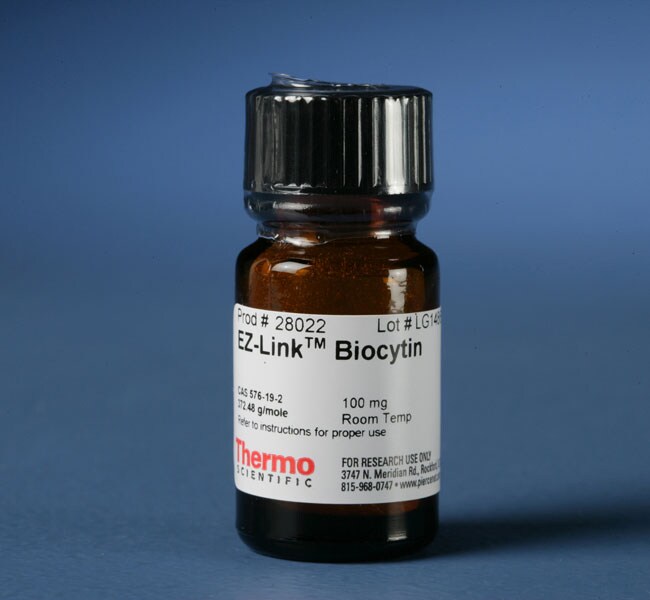
Thermo Scientific EZ-Link Biocytin is a simple variant of biotin that contains a primary amine in its valeric acid chain, which provides the essential backbone for construction of certain long-chain and trifunctional biotinylation reagents.
Features of EZ-Link Biocytin:
• Biotinylation—label molecules and surfaces for assays or affinity purification methods involving avidin or streptavidin probes and resins
• Amine-activated—primary amine can be crosslinked to proteins and material surfaces using EDC and other crosslinkers
• Lysine derivative—functions as a biotin-tagged amino acid; potentially useful as a control or quenching reagent in biotin assay methods
• Medium length—spacer arm (total length added to target) is 20.1 angstroms, representing a 7-atom extension of the native biotin valeric acid
Biocytin is ε-N-[d-biotinyl]-L-lysine, a compound formed by conjugation of the epsilon amine of lysine to the valeric acid side chain of biotin. It contains terminal carboxyl and amino groups, which provide functional handles for derivatization or conjugation to proteins, surfaces and other molecules. Carbodiimide (EDC) and NHS-ester crosslinker chemistries are most often utilized for covalent modifications involving biocytin. The compound is also useful as an amino acid control or biotin standard in assay methods involving streptavidin binding.
We manufacture biotin reagents to ensure the highest possible overall product integrity, consistency and performance for the intended research applications.
Amino-biotin compounds can be conjugated to functional groups of proteins and other molecules in a variety of ways. The most common method is to crosslink the terminal primary amine to carboxyl groups using . Carboxyl groups (-COOH) occur in aspartate or glutamate residues and the carboxy-terminus of polypeptides. When activated with EDC (Part No. 22980), carboxylates react with amino (—NH2) groups to form amide bonds.
Biocytin has both carboxyl and amino groups. Therefore, to prevent self-conjugation of biocytin, EDC-mediated reaction schemes with this compound are usually done in two steps, aided by Sulfo-NHS (Part No. 24510): (1) Activate a carboxylate molecule using EDC and Sulfo-NHS, followed by complete removal or inactivation of the EDC reagent; then (2) Add Biocytin to allow its primary amine to react with the Sulfo-NHS ester-activated carboxyl groups. See NHS-ester Chemistry. Subsequently, the remaining carboxyl group of biocytin could be conjugated to yet another molecule. For example, biocytin is the starting material for synthesis of Sulfo-SBED (Part No. 33033), a trifunctional reagent.
| Code | Description |
|---|---|
| 28022 | Catalog Number: 28022 |

